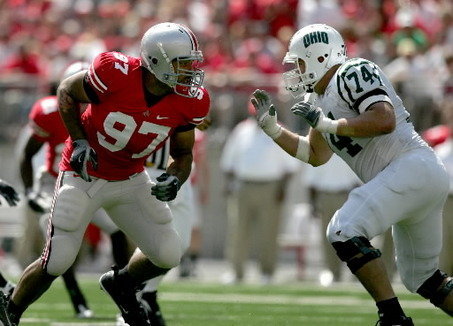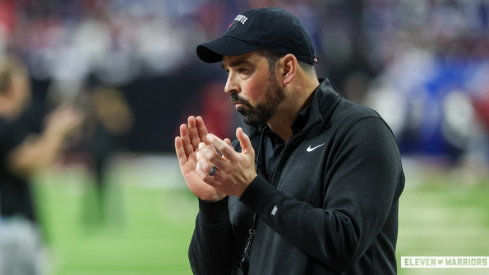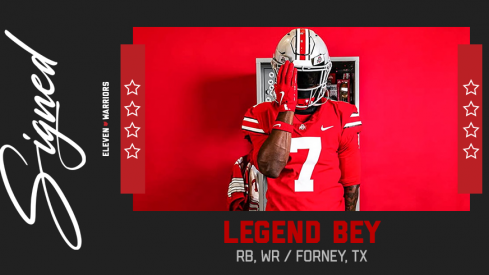
If you had asked me before the season started how many sacks the defense would have, I probably would've said something like "a billion" and stared at you for a long time without blinking to convey just how serious I was about that number. I mean, Cam Heyward? Nathan Williams? Big Dex and Simon and He Ate Me clogging up the middle? How could I possibly have been anything other than completely and totally dead on with my prediction?
Of course, it's 8 games into the season and the entire defense as a whole stands about 999,999,990 sacks away from my original estimate, which has made me feel somewhat silly and caused no small amount of consternation in Buckeye land.
But wait! It gets worse! It's not just sacks. The 2010 Buckeye defense is on pace to establish a 5 year low in tackles for loss as well! Add that on top of a secondary currently held together with duct tape and wet newspaper and we are totally and completely screwed. Right? Well, maybe. But maybe not. One thing that Ohio State has been particularly great at in the past several seasons is putting up terrific numbers on defense without looking amazingly great in the "sexy" defensive stats. What I'm getting at here is that it is much more important to look at the full body of work of a defense than several choice defensive categories. The system that Luke Fickell and Jim Heacock have put into place in the last three seasons or so are an excellent example of this in practice, and we will get to why in a little bit.
But first, some stats:
| Points Allowed Per Game (National Rank) | Total Defense: Yards (NR) | Passing Defense: Y (NR) | Rushing Defense: Y (NR) | Interceptions: # (NR) | Sacks: # (NR) | Tackles For Loss: # (NR) | |
|---|---|---|---|---|---|---|---|
| 2010 (through 8 games) | 14 (9th) | 234 ypg (3rd) | 148.8 ypg (5th) | 85.3 ypg (5th) | 14 (2nd) | 10 (93rd) | 42 (61st) |
| 2009 | 15.5 (5th) | 262 ypg (5th) | 171.5 ypg (13th) | 90.8 ypg (7th) | 24 (2nd) | 31 (29th) | 78.5 (42nd) |
| 2008 | 13.9 (6th) | 293.8 ypg (14th) | 183.5 ypg (25th) | 110.2 ypg (18th) | 15 (39th) | 27 (49th) | 76 (50th) |
| 2007 | 12.8 (1st) | 233 ypg (1st) | 150 ypg (1st) | 82.9 ypg (3rd) | 11 (73rd) | 42 (7th) | 100 (11th) |
| 2006 | 12.8 (5th) | 280 ypg (12th) | 182 ypg (30th) | 98.3 ypg (15th) | 21 (3rd) | 38 (11th) | 93 (13th) |
One interesting thing that immediately pops out when looking at this chart is how statistically similar the 2010 Ohio State defense is to the 2007 Ohio State defense in terms of yardage allowed. The amount of passing yards allowed, rushing yards allowed, and total yards allowed are virtually identical. However, the "sexy" stats for each defenses couldn't be more different. 2007 far outpaces 2010 in terms of tackles for loss and sacks, but in just 8 games 2010 already has three more INTs than 2007 could come up with for an entire season.
There are other oddities. 2008 had roughly the same amount of TFLs and sacks as 2009 did, but still gave up nearly 20 yards more on the ground per game (and 2009 faced several very prolific rushing attacks). 2010 will likely finish with fewer TFLs than any team in the last 5 years, but could still finish as the best in terms of yardage allowed per game. 2010 might be the best pass defense since 2007, but could also finish with half the sacks and TFLs that team had.
The overall point that I'm trying to make here is that the first four statistical categories in that graph are far, far more important in a macro sense than the last three, as INTs, sacks, and TFLs are largely transitory and heavily reliant on particular players and opponents. For example, in 2007, Vernon Gholston accounted for 14 of those 42 sacks. On the other hand, the average yards and points allowed per game speak more to a particular scheme devised by the coaches. Which brings me to my next point.
Scheme
Why does the Ohio State defense continue to be so good statistically without a large number of "sexy" stats across the board, especially this year, given the incredible amount of injuries in the secondary? In my opinion, a lot of this can be attributed to the Star position and the hybrid DE/LB that have come into favor with the OSU coaching staff in the last 4 or 5 seasons. Where other schools might overlook guys like Tyler Moeller, Thaddeus Gibson, or Christian Bryant, these were prized recruits by Heacock and company because of their versatility and "tween"-ness. In addition, Heyward is a hybrid DT/DE, Williams and Sweat have shared Gibson's old spot, and even Homan lacks "ideal" LB size. But they are the perfect kind of players to work in a defense that shifts between a 3-4, 4-3, or a 3-3-5 whenever the situation calls for it.
In theory, what these new positions and players bring to the table is an ability to be effective against virtually any type of offense without the need for a prototypical bull rush end or nose tackle or so on. Because of this, some statistics may suffer, but the ones that count will not.
Going Forward
The system isn't infallible. Against Wisconsin, the defensive line got completely chewed up by a very mobile offensive line for large parts of the game. Against USC in both 2009 and 2008 the secondary simply got beat during key parts of the game.
But when it works, it works very very well. The Rose Bowl game against Oregon was remarkable because although it was a somewhat close game and OSU was only +1 in turnover differential and had only 1 sack, the defense completely befuddled one of the best offenses in the country, holding them to only 81 yards passing and 260 yards in total. Any time that a team can force its opponent to be that one dimensional and hold them to that amount of yards, they will have an excellent chance to win the game.
I do agree with what Keith wrote yesterday in that players like Cam Heyward need to step up their game for the last part of the season. But I do not believe that that necessarily means that we need to see a huge jump in sacks or TFLs, and I truly believe that an OSU defense that includes accidental starters such as Sweat, Gant, Hines at Star, and Orhian Joshnson at safety is still one of the best in the country. The team cannot afford another Wisconsin style letdown, but if the defense plays disciplined, smart football, the scheme and the ability of the 'tweeners to adapt to different offenses should be plenty get the team through the end of the year.

